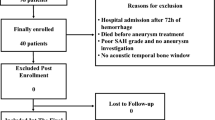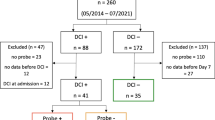Abstract
Purpose:
The aim of this prospective study was to evaluate changes of regional cerebral blood flow (rCBF) and regional cerebral blood volume (rCBV) in the first days after aneurysmal subarachnoid hemorrhage (SAH) in patients with and without unilateral cerebral vasospasm (CVS).
Patients and Methods:
In 48 patients perfusion-weighted magnetic resonance imaging (MRI) and digital subtraction angiography (DSA) were performed 5 ± 3 days after SAH. Local CVS was analyzed in the anterior cerebral artery (ACA) and middle cerebral artery (MCA) territory as well as in the basal ganglia. Each territory was compared with the corresponding contralateral area and SAH patients (control group) exhibiting no signs of CVS on follow-up DSA. Ratios of rCBV and rCBF of the vasospastic and the corresponding contralateral territory of local mild (11–33%), moderate (34–66%) and severe CVS (67–100%) were statistically evaluated using the Kruskal-Wallis test followed by Conover-Iman post-hoc test.
Results:
A significant decrease of rCBF under moderate CVS was seen in the ACA territory and in the basal ganglia in comparison to the control group of SAH patients without CVS (p < 0.05); furthermore, in the ACA territory rCBF significantly decreased under moderate CVS in comparison to mild CVS (p < 0.01). Comparison of rCBV in all three areas showed no significant differences in all grades of CVS.
Conclusion:
Regional CBV as an indicator of autoregulatory vasodilatation did not increase with higher CVS, suggesting an at least partially impaired autoregulation in the early phase after SAH. However, hemodynamic relevance of this impaired autoregulation might be dependent on the degree of CVS, the vascular territory, and the involvement of the microcirculation.
Zusammenfassung
Ziel:
In dieser prospektiven Studie sollten Veränderungen des regionalen zerebralen Blutflusses (rCBF) und Blutvolumens (rCBV) in den ersten Tagen nach aneurysmatischer Subarachnoidalblutung (SAB) anhand von Patienten mit und ohne unilateralen zerebralen Vasospasmus (CVS) untersucht werden.
Patienten und Methodik:
Bei 48 Patienten wurden 5 ± 3 Tage nach SAB sowohl eine perfusionsgewichtete Magnetresonanztomographie als auch eine digitale Subtraktionsangiographie (DSA) durchgeführt. Der lokale CVS im Territorium der Arteria cerebri anterior (ACA) und der Arteria cerebri media (MCA) sowie in den Stammganglien wurde analysiert. Jedes Areal wurde sowohl mit der korrespondierenden Gegenseite sowie mit SAB-Patienten ohne CVS (Kontrollgruppe) verg addilichen. Die Verhältnisse von rCBV und rCBF der vasospastischen Seite und des korrespondierenden kontralateralen Territoriums bei mildem (11–33%), moderatem (34–66%) und ausgeprägtem CVS (67–100%) wurden mit dem Kruskal-Wallis-Test und dem Conover-Iman-post-hoc-Test statistisch ausgewertet.
Ergebnisse:
Bei moderatem CVS reduzierte sich der rCBF im ACA-Territorium und in den Stammganglien signifikant (p < 0,05) im Vergleich zur Kontrollgruppe ohne CVS; des Weiteren sank der rCBF im ACA-Gebiet unter moderatem CVS auch im Vergleich zum milden CVS signifikant (p < 0,01). Der Vergleich von rCBV aller CVS-Grade der drei untersuchten Areale ergab keine signifikanten Unterschiede.
Schlussfolgerung:
Da das rCBV als Indikator für autoregulative Vasodilatation nicht mit höhergradigem CVS anstieg, sprechen die vorliegenden Daten für eine zumindest partielle Störung der Autoregulation in der Frühphase nach SAB. Die hämodynamische Relevanz dieser Autoregulationsstörung scheint von der Ausprägung des CVS-Grads, vom Gefäßareal und von der möglichen Kompromittierung der Mikrozirkulation abhängig zu sein.
Similar content being viewed by others
Author information
Authors and Affiliations
Corresponding author
Rights and permissions
About this article
Cite this article
Blasel, S., Hattingen, E., Dettmann, E. et al. Assessment of Regional Cerebral Blood Flow and Blood Volume after Aneurysmal Subarachnoid Hemorrhage. Clin Neuroradiol 18, 237–243 (2008). https://doi.org/10.1007/s00062-008-8030-8
Received:
Accepted:
Published:
Issue Date:
DOI: https://doi.org/10.1007/s00062-008-8030-8
Key Words:
- Subarachnoid hemorrhage
- Regional cerebral blood flow
- Regional cerebral blood volume
- Cerebral vasospasm
- Autoregulation




